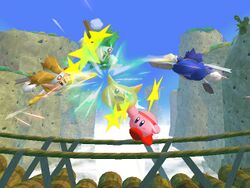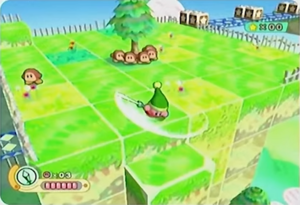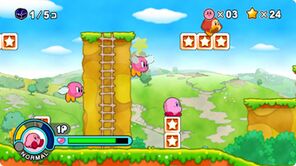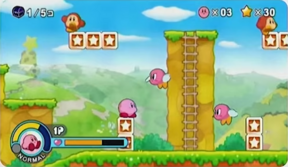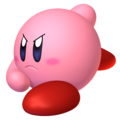Kirby for Nintendo GameCube
| ||||||||||||||
|
| ||||||||||||||
| “ | Kirby's first full-scale action game arrives on the Nintendo GameCube with a variety of modes, including a wild multiplayer adventure! The story begins when Kirby sets out to get the stolen Warpstar back from King Dedede. It's tough going for Kirby when he's on his own... so it's a good thing he can catch a ride on the backs of his helpers. Kirby can activate awesome attacks to help him on his way. Can Kirby save the beautiful worlds of Dream Land? | ” | — Official synopsis from an E3 2005 press release |
Kirby for Nintendo GameCube[2][3] was the tentative title for an unreleased mainline Kirby game developed for the Nintendo GameCube. Announced in 2004, it featured a revamped Helper system based on that of Kirby Super Star, alongside the camera perspective used in Kirby 64: The Crystal Shards. It began development in 2000, shortly after development for Kirby 64 concluded,[4] and was planned for release soon after Kirby Air Ride in 2003.[4] Its initial announced release date was 2005, which was later pushed back to 2006. However, due to the difficulty of designing a game for both single-player and multi-player, it was eventually canceled, most likely sometime in 2006.[4] Had it been released as intended, it would have been the eighth game in the main series.
Three more builds of the game followed, with development eventually transferring over to the Wii. Only the last of these was released, under the title Kirby's Return to Dream Land.[4] The concept for this game would later be revisited in Kirby Star Allies for the Nintendo Switch.
Overview[edit]
Much like Kirby 64: The Crystal Shards, this game would have been a side-scroller with 3D graphics presented on a 2D plane. It featured a Helper system similar to the one in Kirby Super Star, but allowed up to 3 Helpers at a time instead of just one. Enemies and Mid-Bosses could be stunned by the attacks of Kirby and his helpers. The story would have seen Kirby on a quest to retrieve the Warp Star, which had been stolen by King Dedede, who uses it to power his new robot, Dedede Robo.[5] Official press releases seem to imply that the game would use a similar "compilation" format as Kirby Super Star, with concept art for the main menu shown in the 20th Anniversary Kirby Pupupu Encyclopedia depicting a variety of menu options formatted as a stack of boxes.[6]
The game started development in 2000, shortly after the release of Kirby 64: The Crystal Shards, and was intended to release soon after Kirby Air Ride in 2003. It was announced in November 2004,[1] and trailers and press screenshots were shown during E3 2005,[7], though nothing more would come of it.
Enemies/Helpers[edit]
Enemies who appeared in this version included the following:
| Enemy | Copy Ability | Notes |
|---|---|---|
| Babut | ||
| Blade Knight | Sword | Spin Slash was first introduced in this version. |
| Blipper | ||
| Bonkers | Hammer | |
| Bronto Burt | ||
| Broom Hatter | Cleaning | The Cleaning ability didn't return until Kirby Star Allies. |
| Chilly | Ice | |
| Dale | Dale only appeared in Kirby Air Ride so far. | |
| Flappy | Wing | Flappy only appeared in Kirby Air Ride so far. When only Kirby rode piggyback on Flappy, he wore a helmet similar to that of Wheelie Rider. |
| Glunk | ||
| Golem | Stone | Golem only appeared in Kirby & The Amazing Mirror so far. |
| Heat Phanphan | Fire | Heat Phanphan only appeared in Kirby Air Ride so far. |
| Knuckle Joe | Fighter | |
| Parasol Waddle Dee | Parasol | |
| Plasma Wisp | Plasma | |
| Scarfy | ||
| Sir Kibble | Cutter | |
| Waddle Dee | ||
| Waddle Doo | Beam | |
| Wheelie | Wheel | When only Kirby rode piggyback on Wheelie, he wore a helmet similar to that of Wheelie Rider. |
| Unidentified enemy | Bomb | The enemy was a mini clown riding a relatively big jester ball. |
| Unidentified enemy | Tornado | The enemy resembled a fairy. |
| Unidentified enemy | Water | The enemy resembled a group of three water droplets similar to Pluid. |
Abilities[edit]
Several different copy abilities were demonstrated in this title, though some were only shown through their Helper. In total, at least 16 abilities were confirmed or implied to appear.
| Name | Obtained from | Notes |
|---|---|---|
| Beam | Waddle Doo | Never directly seen, but reasonably assumed due to Waddle Doo's appearance. Appears as a trophy in Super Smash Bros. Brawl. |
| Bomb | Unidentified enemy | The ability's hat was redesigned to an orange party hat with yellow patterns, being the basis for its current design debuting in Kirby's Return to Dream Land. |
| Cleaning | Broom Hatter | The ability's hat directly matches that of the anime, having a yellow kerchief with green stars. |
| Cutter | Sir Kibble | |
| Fighter | Knuckle Joe | Appears as a trophy in Brawl. |
| Fire | Heat Phanphan | The ability's hat was redesigned with a hexagonal gem matching that of the anime, which never reappeared outside of Brawl. |
| Ice | Chilly | Never directly seen, but reasonably assumed due to Chilly's appearance. Appears as a trophy in Brawl. |
| Hammer | Bonkers | The ability's hat was redesigned to resemble a construction helmet, which never reappeared in any future title. |
| Parasol | Parasol Waddle Dee | |
| Plasma | Plasma Wisp | Appears as a trophy in Brawl. |
| Stone | Golem | The ability's hat was redesigned to a crown of boulders, being the basis for its current design debuting in Kirby's Return to Dream Land. |
| Sword | Blade Knight | Appears as a trophy in Brawl. |
| Tornado | Unidentified enemy | Never directly seen, but reasonably assumed due to the helper that uses Tornado's moveset. Appears as a trophy in Brawl. |
| Water | Unidentified enemy | The only new ability to be showcased. The ability's design resembles that of the anime, with Kirby taking a translucent blue appearance. This ability would eventually debut in Kirby's Return to Dream Land. |
| Wheel | Wheelie | Never directly seen, but reasonably assumed due to Wheelie's appearance. Wheelie Rider also appears. |
| Wing | Flappy | Never directly seen, but reasonably assumed due to Flappy's appearance. Appears as a trophy in Brawl. |
Bosses[edit]
Bosses who appeared in this version included the following:
- Whispy Woods
- Dedede Robo
- Morpho Knight (designed, but ultimately not put into the game)[8]
The three lost Kirby games[edit]
In an Iwata Asks interview for Kirby's Return to Dream Land, it was revealed that two more builds and concepts for the game existed before the final version; these two concepts alongside the one shown at E3 are collectively referred to as the "three lost Kirby games".[4] Each of the three lost games were said to be "fairly complete", with the third one in particular being "painfully close to completion".[9] A general timeline can be estimated based on investor reports that give release dates for the project.
| Release dates given in investor informational material for Kirby for Nintendo GameCube and its successor projects between E3 2005 and the release of Kirby's Return to Dream Land | |||||||
|---|---|---|---|---|---|---|---|
| Report date | Release date | Title in Japanese report | Reference | Title in English report | Reference | Notes | |
| 2005/05/27 | 星のカービィ(仮称) | [1] | Nintendo provided no English versions of these reports. | First appearance of Kirby for Nintendo GameCube on any of the annual investor reports supplementary material. Listed under the GameCube release schedule. | |||
| 2005/11/25 | 星のカービィ(仮称) | [2] | While still listed for a GameCube release in Japan and the Americas, Kirby is no longer listed for a European release at all, when other games like The Legend of Zelda (working title) still are. | ||||
| 2006/05/26 | 星のカービィ(仮称) | [3] | While still listed for a GameCube release in Japan, Kirby is now no longer listed for an American release either, when The Legend of Zelda (working title) still is (now for 2006/Q4). However, as the latter is also no longer listed for a European release, the omission of Kirby from overseas schedules could be a simple error, or an omission for brevity. | ||||
| 2006/10/27 | 星のカービィ(仮称) | [4] | This is the first time the game is listed under the Wii's release schedule, with GameCube releases no longer shown in these reports. This does not exclude the possibility of Kirby still being developed for the GameCube in addition to the Wii, as The Legend of Zelda: Twilight Princess was. | ||||
| 2007/04/27 | 星のカービィ(仮称) | [5] | Hoshi no Kirby (Temp) | [6] | The game is still listed for a Wii release on a date TBA. This appears to be the first report where investors were provided an English version of the supplementary information via the Nintendo website. | ||
| 2007/10/26 | 星のカービィ(仮称) | [7] | Kirby (Temp.) | [8] | Nintendo assigns the game a release date of 2008, only to delay it to 2009 a year later. | ||
| 2008/01/25 | [9] | [10] | |||||
| 2008/04/25 | [11] | [12] | |||||
| 2008/10/31 | 星のカービィ(仮称) | [13] | Hoshi no Kirby (Temp.) | [14] | |||
| 2009/01/30 | [15] | Hoshi no Kirby(Temp.) | [16] | ||||
| 2009/05/08 | [17] | [18] | |||||
| 2009/07/31 | [19] | [20] | |||||
| 2009/10/30 | [21] | [22] | |||||
| 2010/01/29 | 星のカービィ(仮称) | [23] | Hoshi no Kirby(Temp.) | [24] | Shinya Kumazaki's involvement in Kirby's Return to Dream Land began in March of 2010, when "[t]he third attempt ... had been called off"[4] likely in the months surrounding this report. | ||
| 2010/05/07 | [25] | [26] | At this point, Kirby's Return to Dream Land would have entered the initial stages of development. | ||||
| 2010/07/29 | n/a | n/a | [27] | n/a | [28] | Kirby is not listed as a future Wii release during this time; however, Kirby's Epic Yarn is, which may be the reason why it was removed from the schedule. Some press outlets believed Kirby's Epic Yarn to be the manifestation of the canceled Kirby title.[10] The lack of a public timeline after Kirby's Return to Dream Land began development contrasts with Kumazaki being explicitly given a year and a half to complete the game.[4] | |
| 2010/10/29 | [29] | [30] | |||||
| 2011/01/28 | [31] | [32] | While absent from the actual list of upcoming releases, the still-untitled Kirby game that became Kirby's Return to Dream Land was quietly announced by Nintendo's then-President Satoru Iwata in the actual investor briefing that the supplementary information accompanied. Iwata's presentation confirmed that it was separate from Kirby's Epic Yarn and that HAL Laboratory was working on the project for a 2011 release date. | ||||
| 2011/04/26 | 星のカービィ(仮称) | [33] | Hoshi no Kirby (Temp.) | [34] | After the release of Kirby's Epic Yarn, the untitled Kirby game returns to the lists of future releases, but without any indication of an overseas release. At this point, the game has not had any overseas release dates for seven years. | ||
| 2011/07/29 | 星のカービィ(仮称) | [35] | Kirby Wii (Temp.) | [36] | Kirby Wii was publicly announced at E3 2011. The report indicates overseas releases for the first time since 2005. The distinction in turn strongly suggests that Kirby for Nintendo GameCube was in quite an advanced stage when it was scrapped. | ||
| 2011/10/24 | 星のカービィ Wii | [37] | [38] | Kirby's Return to Dream Land gains its final regional titles and release dates, which Nintendo and HAL Laboratory would meet, over seven years after the E3 2005 showcase featuring Kirby for Nintendo GameCube. | |||
Full 3D platformer[edit]
The second lost game was a full 3D adventure allowing Kirby to freely move around. It looked very similar to Kirby Air Ride in graphical style, though with thick outlines on the character models. It was stated to have extremely challenging gameplay, and was canceled because it did not achieve HAL's quality standards.[4]
Due to the fullscreen proportions of the screenshots, it can be reasonably assumed that the game was developed for the Nintendo GameCube, at least initially. This likely would have been developed between late 2006 and mid-2007, when investor reports changed the game's planned release date from 2006 to "TBA". As such, it likely had the shortest development span of any of the three lost games.
Full 2D platformer[edit]
The third and final lost game was a 2D platformer with clean 2D graphics, similar in art style to Wario Land: Shake It!, though with 3D cel-shaded character models. Only a few screenshots of this game were ever released, but the backdrop and layout looked very similar to Cookie Country from Kirby's Return to Dream Land. The Super Abilities were planned to appear in this build, and they ended up being included in Kirby's Return to Dream Land.[11] One noticeable aspect shown in this build is a counter for Treasures on the heads-up display, suggesting similar gameplay mechanics to Kirby: Squeak Squad.
The game was developed for the Wii, judging by the widescreen proportions of the screenshots. This likely would have been in development from mid-2007 to early 2010; investor reports show that it was targeting a 2008 release date, then 2009, before eventually returning to a TBA release date by early 2010, when the game was canceled for unknown reasons.[4] The development team was ultimately able to complete Kirby's Return to Dream Land in a year and a half due to having materials left over from the three lost Kirby games, with the third game in particular having the strongest influence on the final product.[9]
Legacy[edit]
Several aspects of the three canceled projects would eventually work their way into completed Kirby titles. Among them included the following points:
- The concept of a full 3D Kirby game was likely the inspiration for the 3D environments in the sub-game Kirby 3D Rumble, and later in Kirby's Blowout Blast and Kirby Battle Royale, and would ultimately be realized fully in Kirby and the Forgotten Land.
- Much of the music and other assets developed for Kirby for Nintendo GameCube would be used in Kirby's Return to Dream Land, most noticeably "Road to Victory" (used for The Arena and The True Arena). This track was first heard in the Kirby for Nintendo GameCube trailer during E3 2005, and shares the melody of the theme "Sky Tower" from Kirby's Return to Dream Land. The melody was probably intended to serve as a leitmotif of Kirby for Nintendo GameCube, though it's also widely used in Kirby's Return to Dream Land. Another song carried over from the GameCube game was "Exploring the Cave", which played in the footage shown at E3 2005. Furthermore, several songs in Kirby's Return to Dream Land share a different melody that may have been intended as a leitmotif for one of the later builds.[12]
- Several models and sounds in Kirby's Return to Dream Land's files use the header "GCK", presumably for "GameCube Kirby", indicating that they were originally planned for use in this title.
- Various sound effects used in this title would be later be used in Kirby: Canvas Curse and Kirby: Squeak Squad, including the sound for getting a Copy Ability, the inhale sound, and the sound of Water Kirby's bubble attack (for the Bubble ability's attacks).
- The Kirby series trophies in Super Smash Bros. Brawl appear to use assets from this title, with models such as Golem and the Fire hat, which has a hexagonal jewel rather than the circular one in Kirby Air Ride, being direct matches.
- The Water ability was originally planned to debut in this game, with a different design more closely matching its appearance in the Kirby: Right Back at Ya! anime; it ended up debuting in Kirby's Return to Dream Land instead.
- Dedede Robo, which had initially appeared as a boss for this title, would later appear in Kirby Mass Attack, and later with a new paint job in Kirby's Return to Dream Land as HR-D3, piloted by Metal General EX.
- Morpho Knight, who had initially been designed as a boss for this title, would later debut in Kirby Star Allies and subsequently reappear in Kirby and the Forgotten Land.
- The concept of having three Helpers, along with the return of the Cleaning ability, would eventually manifest in Kirby Star Allies, though taking a slightly different approach.
- The game was initially planned to have an Extra Mode titled "Save Kirby!", where Kirby would've been captured by King Dedede and the player would control a Helper to set out and rescue him. This concept appears to have become the basis for Helper to Hero in Kirby Super Star Ultra and Guest Star ???? Star Allies Go! in Kirby Star Allies.[6]
- The art style of Kirby's Return to Dream Land Deluxe may have been inspired by the art style of the third canceled project, with both notably featuring a storybook-like art style with outlines around the characters.
Gallery[edit]
Artwork of Heat Phanphan, Golem, and Kirby riding on Bonkers
Parasol Kirby and Parasol Waddle Dee
Kirby diving underwater (sans goggles) near two Blippers
Kirby riding on Flappy
Kirby with his Plasma Copy Ability
Kirby attacking Golem with the Parasol Copy Ability
Kirby with his Fire Copy Ability
Concept art of Morpho Knight for Kirby for Nintendo GameCube
Videos[edit]
Kirby for Nintendo GameCube - E3 2005 trailer
|
Short footage from E3 2005
|
Further footage from E3 2005
|
Names in other languages[edit]
| Language | Name | Meaning |
|---|---|---|
| Japanese | 星のカービィ(仮題)[13] Hoshi no Kābyi (kadai) |
Kirby of the Stars (working title) |
| German | Kirby für Nintendo GameCube[14] | Kirby for Nintendo GameCube |
See also[edit]
External links[edit]
- Iwata Asks: Kirby's Return to Dream Land - The Three Lost Kirby Games (interview with Satoru Iwata on Nintendo.com)
- Kirby's Rainbow Resort (fansite)
- Kirbytraum (German fansite) - 1, 2
References
- ↑ 1.0 1.1 https://www.ign.com/articles/2004/11/25/new-cube-titles-announced
- ↑ Nintendo of Japan website (archived)
- ↑ Kirby GCN - Nintendo Press Kit E3 2005 - hungrygoriya - YouTube
- ↑ 4.0 4.1 4.2 4.3 4.4 4.5 4.6 4.7 4.8 Iwata Asks - Kirby's Return to Dream Land - Page 1
- ↑ https://web.archive.org/web/20120306183526/http://cube.ign.com/objects/716/716496.html
- ↑ 6.0 6.1 Scans from 20th Anniversary Kirby Pupupu Encyclopedia which show the main menu and "Save Kirby!"
- ↑ https://youtube.com/watch?v=yy2l5BSBSL0
- ↑ "バルフレイナイトのデザインについては、実はゲームキューブ版の王道『カービィ』を考えていた時に敵の新型ナイトボスとして作られていたデザインなのですよ。" –July 2018 Issue (Nintendo DREAM), pg. 35
(Translation: As for Morpho Knight’s design, it was actually a design that was created for an enemy that was a new type of knight boss when we were planning a mainline “Kirby” game for the GameCube.) - ↑ 9.0 9.1 Iwata Asks - Kirby's Return to Dream Land - Page 2
- ↑ See, for example, this article from Nintendo Life.
- ↑ Iwata Asks - Kirby's Return to Dream Land - Page 3
- ↑ Video showing the secondary leitmotif in Kirby's Return to Dream Land
- ↑ Famitsu article (archived)
- ↑ Produktkatalog 2005, pg. 81
